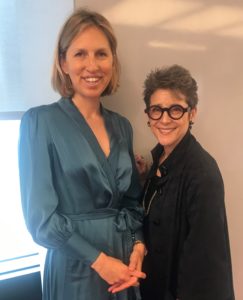


At Golden Seeds, we were honored that Heather Dietrick, CEO of The Daily Beast, joined us earlier this year for a “fireside chat” with Tracey Riese, Managing Director of Golden Seeds, to explore her views of leadership and today’s media landscape. In addition, they discussed how to boost engagement and what tools are out there and whether news will ever truly be objective.
HD: The digital media landscape — as with the overall media landscape — has been incredibly tumultuous over the last four or five years. In fact, a major shift occurred in 2014, which was the era of scale. Media properties like VICE and Buzzfeed received massive valuations and the goal of digital media was to find every last eyeball, user, reader, viewer they possibly could. Facebook’s algorithm was favoring digital media and because of that, traffic to these sites was flowing like an open fire hose.
Of course today, with 20/20 hindsight, we know what happens when a media platform relies on this model. Traffic ultimately went down; they weren’t meeting the very large capital expectations they had incurred and these media properties suffered.
Today, it’s all about engagement. Those media organizations that didn’t chase scale are now well poised for this next period because they spent time with their audiences rather than chasing giant valuations.
Take us at The Daily Beast as an example. We didn’t receive the big valuation, but we very slowly and carefully engaged with our audience. We knew our readers wanted real content — which takes longer to do, but it also builds loyalty and brand affinity. We also try to engage our audience by going out and breaking news.
HD: At The Daily Beast, we are really focused on e-commerce and membership as sources of revenue. For other digital properties, I would say if you’re focused on the engagement track, you shouldn’t plan to rely on direct advertising. Instead, create something for your customers that makes them willing to open their wallets.
I relied on my past experience as president of Gawker Media to think about engagement as a way to build an e-commerce component — both in terms of news content and content about products. And both start with trust.
Your audience has to trust you to bring them the news and they have to trust the recommendations you make.
With so many news sites going behind paywalls, most people are familiar with news subscriptions. We recently launched a membership program, which gives our audience extra exclusive content. A subscription program gets the audience a certain number of stories per month. With a membership, however, it’s like being part of a club, where you can interact directly with journalists and get exclusive content.
HD: We measure engagement in a variety of ways, including time spent on site, number of page views consumed, number of visits to the site per month, and number of visits to our homepage.
HD: We recently launched an e-commerce brand called Scouted by The Daily Beast. For us, venturing into e-commerce wasn’t as obvious of a move as it was for The Verge or The Cut, for example, which produce e-commerce content that is endemic to their journalism.
Most of our traffic is for political news, opinion and entertainment coverage. But today, the landscape is different and people are so used to purchasing on the internet. People are looking for solid recommendations all of the time and our journalists have already earned that trust through their stories, which opened the door for us to launch Scouted and build a business off of that trust.
It’s just as critical to know your buying audience as it is your audience who’s reading your news. For us, our audience has a lot of purchasing power — a household income over $150,000 — ages 45–55, skewing a little female, highly intelligent and hungry for news. We can offer them products that are more curated and tech-forward.
HD: Let’s start with video, which seemed so attractive a few years ago. But I can’t think of a media company that has figured out monetizing onsite video on the web. Users are just not trained to go onto an individual site to watch a video — views come through Facebook or YouTube. Video is difficult to produce, it’s expensive, it requires large teams and it’s much more difficult to produce than a news article.
As far as customization and personalization in news, that’s an interesting topic. Some people feel that their news isn’t as specifically targeted for them as ads, for example. But you have to keep in mind — editors usually believe that you come to them for their concept of what you should know rather than just what some algorithm told you to read.
Regarding nonpartisan news, there are very few news organizations that are totally neutral and don’t get criticism for being one way or the other. Of course we try to be nonpartisan, but it’s also important to show the writer’s biases. It’s very voicey. We want you to know where they’re coming from. And I question whether we should aspire to true and full neutrality. Humans are the ones producing our content and humans are not completely neutral. It might be better to know people’s biases and make a decision about where you get your news knowing that.
HD: I built trust with the employees, showing them I was a partner and making myself available as much as possible. I spent time getting to know employees. When I did break the news about the bankruptcy filing, I made it clear that the employees’ best interests were truly top of mind. You have to have trust as leader.
We also had a culture of radical transparency, so I shared everything I legally could with the team about what was happening.
When employees know what’s going on — the good and the bad — they have confidence there won’t be any big surprises. They also feel respected and like they’re part of the process.
I also reminded people of Gawker’s mission — to tell real stories and share the truth. This mission extended beyond the stories we published — it was ingrained in our culture. Having a mission that everyone bought into was critical to keeping people motivated and focused on their work throughout the sale of the company.
Tracey Reise is an entrepreneur, private investor and company director, nonprofit leader and sought-after speaker in strategy, branding, leadership and culture.